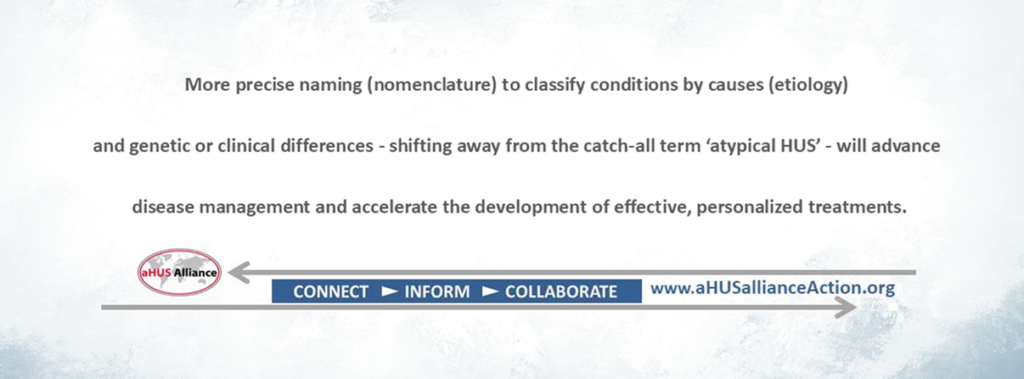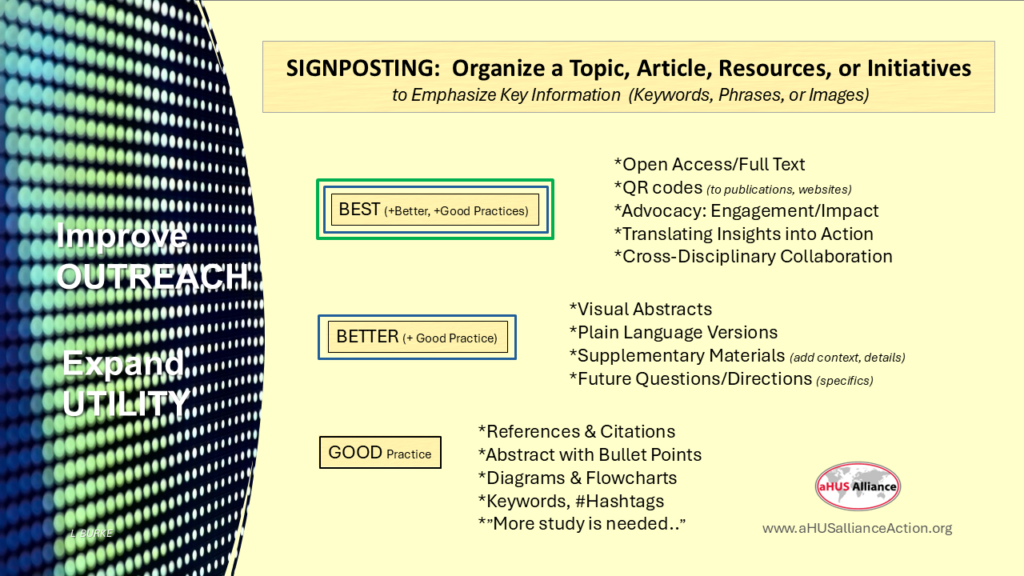
Scientific advancements in the last decade have yielded promising avenues on multiple fronts, including those related to atypical HUS and other thrombotic microangiopathies. However we’ve now reached a point where that knowledge will require different approaches to aHUS/TMA treatments which offer the best outcomes for individual patients. Increasingly scientific studies have pointed to evidence indicating a crossroads with multiple avenues, suggesting adoption of an underlying need for a more ‘Precision Medicine’ approach.
The trick will be to better identify, and label, the ‘type’ of aHUS or TMA to provide optimum care for individual patients – revising current nomenclature. Acquiring new information is important, but effectively organizing it into structured, easily accessible categories is essential for improving patient treatment. This dilemma is similar to mundane situations throughout real life, whether it’s clearing off the top of a desk at work or streamlining home storage. First, create a system for organizing, and next maintain the organization by establishing routines and using tools to help stay on track. There’s no sense in re-inventing the wheel when there already are two commonplace techniques to help organize aHUS/TMA nomenclature: a. Bridge Patterns design and b. Signposting.
Common Strategies for Big Challenges: Bridge Patterns & Signposting
We’ve all driven past bridges under construction, and over time viewed different groups working on specialized task sections (e.g. underwater supports, steel girder and mortar substructures, roadway surfacing). Sometimes working separately, sometimes working concurrently but in various areas or on different tasks, we’ve seen the effectiveness of utilizing ‘the Bridge pattern’ for large projects that would benefit from a multistep approach. Engineers utilize a bridge pattern for various computer software and construction projects, but to ensure a good end project they begin project analysis by setting clear parameters and goals which are well-defined. Scientists and clinician researchers are already making great progress, but to support those efforts and work in a collaborative and synergistic manner we need more clarity on who is doing what. (see below: Applying Bridge Pattern concepts to the aHUS/TMA Arena)
Mindful employment of communications tools known as signposting ensure the current practice of keywords with medical publications will greatly expand: to help others understand the relationship between that article’s information and related areas, to identify in specific terms where that effort launched from and where it could serve as a springboard, to illustrate where that knowledge fits within ‘the big picture’, and to outline future avenues which potentially may yield clarification with anticipation of next steps.
We must go beyond the traditional “More study is needed” statement. Mark the target(s), indicate the efforts start and end points, emphasize how the work fits within shared goals, offer ideas and pathways to explore. Better identification of an individual’s clinical profile can provide a personalized treatment plan that improves patient outcomes, but we currently lack effective organization needed to efficiently make progress. Why is it important to patients and their physicians to begin creating a better system?

Major Traits that Distinguish & Complicate aHUS Care
There are three unique characteristics of aHUS disease management set it apart from other medical conditions, potentially delaying accurate diagnosis and timely treatment:
1. In a major shift from usual medical concepts, atypical HUS diagnosis requires a contrarian approach or review of medical test results to cull out diseases with similar characteristics which differentially ends with aHUS identified in a ‘diagnosis of exclusion’.
2. A complicating factor to aHUS care is its complexity, regarding its different causes and wide differences in damage to organ function or body systems. The name ‘atypical hemolytic uremic syndrome’ contains a main feature of the condition, with ‘uremic’ referring to abnormal kidney function. Considered as an ‘invisible illness’ due to vague and/or few overt symptoms, atypical HUS often escalates rapidly with life threatening damage with extra-renal manifestations.
How does genotype, phenotype, and etiology figure into to determining important facets of health status such as: patient prognosis, risk factors,
3. Most types of aHUS can be classified as ‘complement mediated’ or having a disease state where the complement system portion of the body’s immune system (which protects the body’s own cells and is our first line of defense against infection) is poorly regulated. Those patients can be treated effectively with therapeutic drugs known as complement inhibitors. But what about people whose aHUS isn’t due to a fault involving the complement system? How do we sort through determining best disease management strategies and drug candidates for those patients with aHUS who have mutations in genes not directly linked to the complement system (e.g. diacylglycerol kinase ε or DGKE, plasminogen or PLG, thrombomodulin or THBD)?
Moving toward more concise terminology for aHUS/TMA will be a multi-year effort, likely to involve international collaborations, and covering these aspects among others. Consensus on nomenclature will need to include consideration of how this looks from the perspective of clinical trial candidates and package inserts for approved therapeutic drugs. Gone are the days when the term ‘atypical HUS’ has been utilized to separate ‘regular HUS’ (most commonly E. coli infection/STEC) apart from aHUS caused by genetic mutation or acquired triggers such as pregnancy, surgery, or autoimmune disorders.
More creative positioning and signposting will both enable and encourage content to be accessed at novice, advanced, expert levels, improving outreach and expanding utility. Past practice in various nations’ drug approval process is a component which solicits patient organization statements of patient impact to their country’s policy makers. Development of affordable small molecule therapies may overcome drug policy barriers, expanding treatment access and improving outcomes for aHUS/TMA.
Improved signposting could benefit clinical trial recruitment. While regulations understandably impact patient education materials and informational resources, creation of helpful assets sometimes needlessly languish on website subpages or third party URLs due to lack of signposts. As generalized examples: Many tables, social media ‘MedEd’ posts, or poster abstracts are very intriguing, but often utility is stunted due to lack clarity regarding: publication title/author citations, DOI to content or NCT trial identifiers, or QR codes to the material’s source. Better ‘signposting’ in publications and within studies can assist information flow, and may better provide clear roadmaps for future efforts.

There’s no question that more precise classification and terminology can better guide individualized treatment, with the likelihood of improved patient outcomes. Fragmented information flow yields missed opportunities, and tagging new aHUS/TMA publications and initiatives with generalized key words will continue to slow progress to tailor patient care with more accurate diagnosis and disease management.
More precise naming (nomenclature) to classify conditions by causes (etiology) and genetic or clinical differences—shifting away from the catch-all term ‘atypical HUS’—will advance disease management and accelerate the development of effective, personalized treatments.
Which stakeholders are positioned to champion accelerated progress by integrating structured signposts from the outset, and applying bridge pattern opportunities to drive systemic change in the aHUS/TMA space? The big question remains when and how the multi-year process to revise nomenclature is prioritized, and we look forward to discussions and actions that form bridges to the future of aHUS in all its facets.

Applying Bridge Pattern Concepts to the aHUS/TMA Arena
(Revision of aHUS/TMA Nomenclature, or with future Research)
The Bridge pattern is a structural design pattern that helps decouple abstraction from implementation, allowing them to evolve independently. In a medical study, where there are closely related terminology and conditions, the Bridge pattern can be effectively used to separate these into two areas:
- Concepts (Abstraction Layer): This represents high-level medical terminology, such as diseases, symptoms, and classifications.
- Implementation (Concrete Implementations): This represents how these concepts are processed, categorized, or analyzed (e.g., different study methodologies, datasets, or statistical models).
How the Bridge Pattern can be utilized as a Methodology in aHUS/TMA Efforts
Concepts (Abstraction Layer)
- Defines medical terminology and conditions at a conceptual level.
- Allows or can include structures like Disease Categories (e.g., Cardiovascular, Neurological), Symptoms (e.g., Chest Pain, Fatigue), and Study Types (e.g., Case-Control, Cohort Studies).
- The abstraction contains a reference (bridge) to the implementation.
Implementation (Concrete Implementations)
- Begins dialogue for future nomenclature collaborations and other efforts, better defines and distinguishes among types/subtypes of aHUS/TMA
- Provides potential starting points for future work of working groups, clinical trials & other efforts
- Signposts parameters with clear start/end points as well as defined goals to allow concurrent or subsequent projects to more efficiently build upon new knowledge gains
- Pinpoints specific areas that need additional exploration or problem-solving efforts
- Gathers possible future financial support from other stakeholders (industry, pharma, etc)
- Handles the underlying study methodology, data storage, or analysis technique.
- Identifies aspects to implement/create regarding various methods of studying or categorizing the conditions (e.g., AI-driven analysis, manual statistical methods, real-world data collection techniques).
More articles on Proposed Changes to Revise the term ‘Atypical HUS’ (original content):
- On current Nomenclature, Term Variations, and Issues: ‘All is Quiet on the aHUS Naming Front’
- aHUS international Advocates: their Insights into Nomenclature

